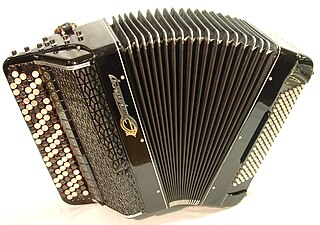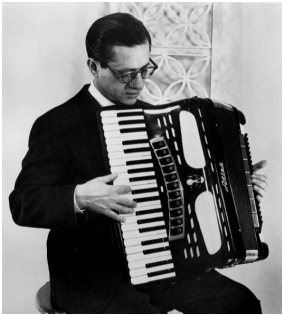Related Research Articles

Accordions are a family of box-shaped musical instruments of the bellows-driven free reed aerophone type. The essential characteristic of the accordion is to combine in one instrument a melody section, also called the diskant, usually on the right-hand keyboard, with an accompaniment or Basso continuo functionality on the left-hand. The musician normally plays the melody on buttons or keys on the right-hand side, and the accompaniment on bass or pre-set chord buttons on the left-hand side. A person who plays the accordion is called an accordionist.

An orchestra is a large instrumental ensemble typical of classical music, which combines instruments from different families. There are typically four main sections of instruments:
A concerto is, from the late Baroque era, mostly understood as an instrumental composition, written for one or more soloists accompanied by an orchestra or other ensemble. The typical three-movement structure, a slow movement preceded and followed by fast movements, became a standard from the early 18th century.
Julius Baker was one of the foremost American orchestral flute players. During the course of five decades he concertized with several of America's premier orchestral ensembles including the Chicago Symphony and the New York Philharmonic Orchestra.
A rhapsody in music is a one-movement work that is episodic yet integrated, free-flowing in structure, featuring a range of highly contrasted moods, colour, and tonality. An air of spontaneous inspiration and a sense of improvisation make it freer in form than a set of variations.

The bayan is a type of chromatic button accordion developed in the Russian Empire in the early 20th century and named after the 11th-century bard Boyan.

John Serry Sr. was an American concert accordionist, arranger, composer, organist, and educator. He performed on the CBS Radio and Television networks and contributed to Voice of America's cultural diplomacy initiatives during the Golden Age of Radio. He also concertized on the accordion as a member of several orchestras and jazz ensembles for nearly forty years between the 1930s and 1960s.

Squeeze Play is an Ultra High Fidelity monaural phonographic album which was released on the Dot Records label in 1956 (DLP-3024) featuring John Serry Sr. It includes an original composition by Serry, classical works, and popular music of the era. Ben Selvin serves as the musical director/producer for the album. The works were arranged by Serry and performed with his ensemble featuring two accordions, piano, guitar, bass, drum, vibes, and marimba.

RCA Thesaurus, a brand owned by RCA Victor, was a supplier of electrical transcriptions. It enjoyed a long history of producing electrical transcriptions of music for radio broadcasting which dated back to NBC's Radio Recording Division.

American Rhapsody was written for the accordion by John Serry Sr. in 1955 and subsequently transcribed for the free-bass accordion in 1963 and for the piano in 2002. The composer was inspired by the classical orchestral works of George Gershwin along with various Latin jazz percussive rhythms utilized throughout South America while composing this opus.

Concerto for Free Bass Accordion was written for the solo free-bass system accordion by John Serry Sr. in 1964 and was revised in 1966. A transcription for solo piano was completed in 1995 and revised in 2002. Written in the classical music concerto form, it illustrates the wide-ranging orchestral qualities of the free-bass accordion and underscores the suitability of the instrument for performances as a robust solo instrument on the classical concert stage.
Heinz Karl "Nali" Gruber, who styles himself HK Gruber professionally, is an Austrian composer, conductor, double bass player and singer. He is a leading figure of the so-called Third Viennese School.
A solo concerto is a musical form which features a single solo instrument with the melody line, accompanied by an orchestra. Traditionally, there are three movements in a solo concerto, consisting of a fast section, a slow and lyrical section, and then another fast section. However, there are many examples of concertos that do not conform to this plan.
Oscar G. Zimmerman was an American musician, teacher and double-bass player.

A free-bass system is a system of left-hand bass buttons on an accordion, arranged to give the performer greater ability to play melodies with the left-hand and form one's own chords. The left-hand buttonboard consists of single-note buttons with a range of three octaves or more, in contrast to the standard Stradella bass system, which offers a shorter range of single bass notes, plus preset major, minor, dominant seventh, and diminished chord buttons. The term "free-bass system" refers to various left-hand manual systems that provide this functionality: The Stradella system does not have buttons for different octaves of the bass notes, which limits the types of melodies and basslines that can be performed with the left hand.
Mogens Ellegaard was an accordion player from Denmark. He is regarded as the "father of the classical accordion."
The accordion is in a wide variety of musical genres, mainly in traditional and popular music. In some regions, such as in Europe and North America, it has become mainly restricted to traditional, folk and ethnic music. Nonetheless, the button accordion (melodeon) and the piano accordion are widely taught and played in Ireland, and have remained a steady fixture within Irish traditional music, both in Ireland and abroad, particularly in the United States and Great Britain. Numerous virtuoso Irish accordion players have recorded many albums over the past century or so; the earliest Irish music records were made in the 1920s, in New York City, by fiddler and Sligo immigrant Michael Coleman, widely considered to have paved the way for other traditional musicians to record themselves. Accordions are also played within other Celtic styles, as well as in English traditional music, American traditional music, polka, Galician folk music, and Eastern European folk music.
John Serry Jr. is an American jazz pianist and composer, as well as a composer of contemporary classical music works that feature percussion, on which he also doubles. He is a son of the accordionist and composer John Serry. His debut solo album was 'Exhibition', for which he received a Grammy Nomination for his composition, 'Sabotage'.
Alexander Sevastian, "Sasha", was a well-known virtuoso Russian-Canadian accordionist.
Robert Davine was an internationally recognized concert accordionist and Professor of Accordion and Music Theory at the University of Denver's Lamont School of Music. As the chairman of the Department of Accordion for three decades, he is credited with establishing one of the few collegiate academic programs in advanced accordion studies offered in the United States during the 1950s. His concert performances of 20th century classical music with leading orchestras and chamber ensembles helped to demonstrate the accordion's suitability as an orchestral instrument on the modern concert hall stage.
References
- ↑ The Year in American Music. Julus Bloom. Allen Towne and Heath Inc., 1948 "Theme and Varioations for Accordion and Orchestra by Roy Harris premiered by Harris conducting in 1948" on https://books.google.com
- ↑ Accordionist Robert Davine - A Conversation With Bruce Duffie - "Roy Harris and his Theme and Variations for Accordion and Orchestra composed in 1947 cited as a concerto by Professor Robert Davine - Lamont School of Music - University of Denver" on kcstudio.com
- ↑ Library of Congress Copyright Office - Catalog of Copyright Entries: Third Series Music July-December 1968, Vol. 22, Part 5, Number 2, Section 1, published 1970, p. 1626 "Concerto in C Major for Bassetti Accordion" Op. 1 John Serry 1968, Solo Arrangement Jan. 1, 1968 No. EP247602 on https://books.google.com
- ↑ Eastman School of Music - University of Rochester - Sibley Music Library: John J. Serry Sr. Collection score "Concerto in C Major (1967) for Free Bass Accordion " Folder 15 & 16 p. 10 archived at the University of Rochester Eastman School of Music Sibley Music Library Special collections on esm.rochester.edu